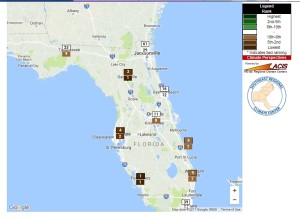
Southeast Climate Perspectives shows total rainfall rankings for the 6 month period October 1 to March 31. The number 1 indicates the lowest recorded rainfall for the 6 month period.
Recent rainfall was very welcome by farmers and ranchers in north central Florida. However, it will do little to make up for the dry conditions experienced from October through March. Southeast Climate Perspectives from the Southeast Regional Climate Center shows that the total rainfall for the 6 month period from October 1 to March 31 ranks as the lowest to 2nd lowest recorded, depending on the location in north central Florida.
This dryness has led to major challenges and significant agricultural losses. These losses include poor grazing conditions of pastures, low germination of winter annual crops, and crop failure of winter annuals which needed late winter moisture for grain fill. Winter planted pine plantations have also suffered losses.
According to the Florida state climatologist Dr. David Zierden, the dry conditions coincided with above average temperatures. “For the state of Florida as a whole, it has been 13 consecutive months of abnormally high temperatures. Those included two record warm months, one ranked second, and seven months in the top ten warmest,” said Zierden.
Radar estimates show 8-12” of rain in a band across portions of Taylor, Lafayette, Suwannee, and Columbia Counties recently. This beneficial rain fall is very timely. It coincides with green-up of summer pastures and improves planting conditions for spring crops such as corn, peanuts, soybeans, and vegetables. The month of May is traditionally the driest in north central Florida with an average of 2.3” of precipitation.
